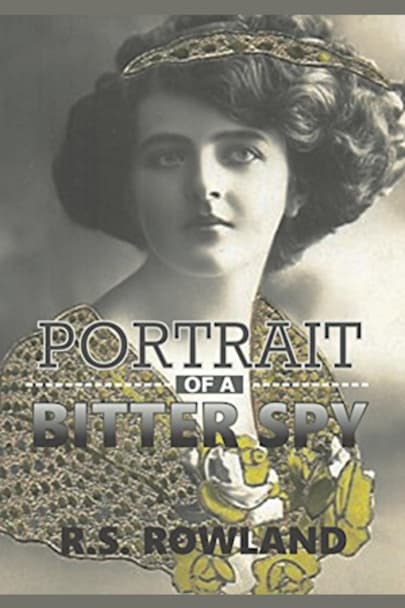Josefa Bygel is a difficult young woman – obstinate, different. She always has been and now recently widowed, she has the opportunity to be very difficult by serving Germany during the Great War as a spy. Newly trained, her first assignment finds her in Paris where she insinuates herself into the life of a lonely executive to obtain the plans for the new tank by whatever means. Breaking into … factories, hiding out in opium dens – how different her life is now. So different from her carefree days as an art student where her last summer before marriage was spent painting botanical illustrations for a young English botany student in Spain. But just like everything else in her life, those happy days dissolved away in August 1914.
For botany student Fleming Hughes, the war has interrupted his research. He joins the Royal Field Artillery and soon after training he is at the front directing fire on the German lines from C Battery. After being wounded, he finds that he can be useful still by joining MI5. He has no idea that the trajectory of his life is racing along a parallel track with the lovely Josefa. He’d quite gotten over his crush from that summer he’d hired her to illustrate his fieldwork. But that was so long ago, before his heart had been pierced by the death of so many people he cared about. And now he not only spends his days pursuing German spies on British soil along with dodging the maddeningly silent spirits of lost mates who haunt him (literally). He is also keeping company with the elegant Davina Fitzgerald. So why has he kept that postcard of Josefa all this time? That wretched postcard
more



Astonishing in detail and vibrant in description, RS Rowland’s lavish portrait about the lives of a British soldier and his love interest turned German spy is a brilliant read. “Portrait of a Bitter Spy” is a stunningly detailed montage about Josefa—a beautiful, wealthy young heiress and artist, who is within just a short time, transformed by the death of her husband at the onset of World War I into a German agent who learns and performs her job with startling efficiency, while Fleming—a British botany graduate student turned soldier loses his opportunity for true love with Josefa due to bad-timing and her prior engagement to a German officer.
The plotline of “Portrait of a Bitter Spy” is well-paced and attentive to every detail as Rowland fully discloses her characters’ experiences in a pensive and enthralling narrative. Nothing is overlooked by this author as she whisks readers away on a journey that takes her two main characters from innocent days spent gathering plant samples and rendering the most exquisite paintings of the Spanish coast to the bitterness of a world war and finding themselves on opposite sides of the fence. The author’s ability to express her characters’ emotions without sounding over-the-top or self-obsessed renders a story that is both provocative and profound.
At 486 pages, this novel is lengthier than most, but every word drips with danger and romance. Rowland pours out the details of Josefa’s life as a flamboyant, high-society undercover agent intent on securing military information for the advancement of the Fatherland’s war effort. Meanwhile, the author elicits deep emotions with her haunting images of Fleming and the valorous men who fought alongside him in the trenches as she painstakingly describes horrific battle scenes that are based directly on her own grandfather’s historical accounts of the action he saw in 82nd Division of Battery D’s heavy artillery unit in France during WWI. In contrast to Fleming’s mind-jolting experiences, Josefa is put-to-task posing as society’s darling when she’s trained by the elite group of individuals responsible for maintaining Germany’s spy system. In each protagonist, we see major transformations in their overall characters as they go from happy-go-lucky young adults to seasoned veterans of war.
“Portrait of a Bitter Spy” is an emotional, oftentimes bittersweet tale about two people embroiled in war. It demonstrates that the casualties of war are not only those individuals fighting on the front lines but those operating outside the sphere of battle—those working on the fringes of society to further their nation’s cause and protect the ideals of their country.
Rowland has certainly accomplished a great deal of research on Britain and Europe in the World War I era, including the culture, politics, society, landmarks, entertainment, and women’s roles. The author has additionally widened her scope by encompassing those individuals living on the fringes of society whose behavior was often considered shocking or deviant at that time—drug addicts, gypsies, homosexuals, etc.—making this a most fascinating and revealing read. As an historian, I feel this novel would be an excellent accompaniment to any college course dealing with the culture and/or society of Britain and Europe, women’s studies, or espionage during the WWI era.
There were quite a few typographical errors in this book at the time I read it, along with a copious use of parentheses to outline a character’s self-admonitions and thought processes in place of the more familiar and traditionally accepted writing method of italicization with which most readers are acquainted, making this a somewhat laborious read in that one often has to reread sections of the story in order to determine which portions of the narrative are intended to be mute and which are spoken aloud by the characters. These writing issues, however, detract little from the overall enjoyment of this well conceived and absorbing read.
“Portrait of a Bitter Spy” does contain adult themes, sexual situations, and graphic violence, and so I recommend this book for ages 17 and up.